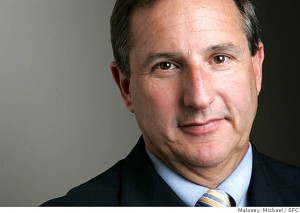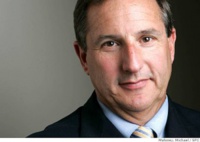In our first discussion Mark Hurd, CEO of Oracle, indicated that Oracle was the top cloud company in the world despite profound market changes.
I/ Generational change
Also, there is a profound change and how consumers are behaving. Indeed, in the past, Mark Hurd mentioned that CEOs were taught to ensure a 95% customer satisfaction, considering that getting every single customer happy would increase cost much more than it would increase revenue. Today, websites like Yelp and Trip Advisor provide a forum for happy and unhappy customers alike. If a customer is unhappy, he can reach a worldwide audience right away. Therefore, companies can no longer accept a 95% customer satisfaction rate. They can choose between one of the two following options:
• get every single customer satisfied
• find a clever way not to recruit customers that may turn out to be unhappy with the company's product
II/ Workforce change
In addition to a changing consumer landscape there is also a profound generational change is affecting every single company in the corporate world. Generation Y, a generation that was born between 1980 and 2000 to use a large panel, is behaving according to very different value sets. For example, Mark Hurd and mentioned that generation Y employees prefer flexibility over additional pay. In addition, they have left their first company only three years after they have been hired. In addition, thanks to the Internet, they have developed a habit of entering into a dialogue with corporate brands while the previous generation would just accept a company's product offering as it was.
Besides, it seems like Generation Y is much more happy working in a collaborative, open workspace than working in a vertical, hierarchical, closed workspace. This behavioral change has many implications regarding technology, software and the corporate life.
Whereas the old information age was very much a replica of paper-based processes, the new digital age is leading us to less of a sequential workflow.
Finally, there's a trend that the retirement age will be pushed back all the way to 72 years old, up from the late 50s only a few years ago. So Human Resources leaders are have to manage three different generations. So, human resources leaders are having to manage a three generation four.
III/ IT change
Finally, there's another profound change that is going on. IT is moving from on-premises infrastructure to a cloud-based infrastructure. In the past, when an IT provider like Oracle would develop a new product, they would sell it to a client. The client would receive a CD containing the program files. When the client would receive the program, he would install the software on-premises, in his office. They would then have to hire a systems’ integrator to integrate the newly purchased software into the company’s IT infrastructure. This would typically last two years.
Two years later, Oracle would come out with a new version of its software. It would send it out to its clients again. The clients would have to integrate it with its IT infrastructure. In other words every single product update would require IT integration. But today, cloud-based technologies are completely changing the process. All the IT, the hardware, the software, the middleware, is based in the cloud. Clients do not need to have hardware, software and middleware on premises if they don't want to your
When Oracle comes up with a new release, the releases are automatically installed on the cloud so that every single client can decide to opt in for the release and enjoy the new features instantly. There is no need to call on to a systems integrator.
This means a lower costs for the client who doesn't have to pay a systems integrator for every single release. It also means increased access the innovation. Clients no longer have to wait several years anymore to enjoy the latest features that Oracle has developed.
For Oracle, the great news is that they can have their entire client base benefit from their latest innovations instantly without having to duplicate work. In other words, they don't have to install every single new feature in every single client's office. This means higher-margin. This is part of the reason why Oracle is able to growth revenue while business-to-business IT spending is remaining stable.
IV/ Turning Oracle into a cloud leader
Mark Hurd made an analogy between the automobile industry in the early 20th century and the cloud industry today.
The automobile industry
When the automobile industry started out, at the very beginning of the 20th first century, before Henry Ford created the Model T, there were thousands of suppliers who specialized in different parts of the car. One will specialize in pistons, another in wheels and so on. Automobile carmakers would manufacture cars by assembling parts coming from different suppliers. But then, when Henry Ford created the Model T and its electricity-powered factories, vertical integration became the new production standard in the automobile industry. In other words, one carmaker would make every single part and assemble them internally before client delivery.
The cloud industry
The cloud industry is evolving in much the same way. In the past, the cloud industry was fragmented as different companies would create different patches to address different corporate needs in the value chain. One company may specialize in sales automation, another company may specialize in marketing or human resources. But today, Mark Hurd believes that there will be a tendency to consolidate the industry around enterprise resource planning software. Oracle is looking to acquire companies that offer marketing, Sales optimization solutions to offer a comprehensive solution to create a sustainable competitive advantage.
Thanks to Mark’s strategy, Oracle is the largest cloud player in the world – larger than Salesforce.
V/ To sum up
While Oracles client spending remains flat and there’s a changing landscape affecting consumer behavior, the workforce and the IT industry as whole, Oracle is able to produce great corporate figures by:
• Integrating software, middleware and hardware into the cloud as whole
• Offering an end-to-end solutions helping Oracle’s clients develop a sustainable competitive advantage
I/ Generational change
Also, there is a profound change and how consumers are behaving. Indeed, in the past, Mark Hurd mentioned that CEOs were taught to ensure a 95% customer satisfaction, considering that getting every single customer happy would increase cost much more than it would increase revenue. Today, websites like Yelp and Trip Advisor provide a forum for happy and unhappy customers alike. If a customer is unhappy, he can reach a worldwide audience right away. Therefore, companies can no longer accept a 95% customer satisfaction rate. They can choose between one of the two following options:
• get every single customer satisfied
• find a clever way not to recruit customers that may turn out to be unhappy with the company's product
II/ Workforce change
In addition to a changing consumer landscape there is also a profound generational change is affecting every single company in the corporate world. Generation Y, a generation that was born between 1980 and 2000 to use a large panel, is behaving according to very different value sets. For example, Mark Hurd and mentioned that generation Y employees prefer flexibility over additional pay. In addition, they have left their first company only three years after they have been hired. In addition, thanks to the Internet, they have developed a habit of entering into a dialogue with corporate brands while the previous generation would just accept a company's product offering as it was.
Besides, it seems like Generation Y is much more happy working in a collaborative, open workspace than working in a vertical, hierarchical, closed workspace. This behavioral change has many implications regarding technology, software and the corporate life.
Whereas the old information age was very much a replica of paper-based processes, the new digital age is leading us to less of a sequential workflow.
Finally, there's a trend that the retirement age will be pushed back all the way to 72 years old, up from the late 50s only a few years ago. So Human Resources leaders are have to manage three different generations. So, human resources leaders are having to manage a three generation four.
III/ IT change
Finally, there's another profound change that is going on. IT is moving from on-premises infrastructure to a cloud-based infrastructure. In the past, when an IT provider like Oracle would develop a new product, they would sell it to a client. The client would receive a CD containing the program files. When the client would receive the program, he would install the software on-premises, in his office. They would then have to hire a systems’ integrator to integrate the newly purchased software into the company’s IT infrastructure. This would typically last two years.
Two years later, Oracle would come out with a new version of its software. It would send it out to its clients again. The clients would have to integrate it with its IT infrastructure. In other words every single product update would require IT integration. But today, cloud-based technologies are completely changing the process. All the IT, the hardware, the software, the middleware, is based in the cloud. Clients do not need to have hardware, software and middleware on premises if they don't want to your
When Oracle comes up with a new release, the releases are automatically installed on the cloud so that every single client can decide to opt in for the release and enjoy the new features instantly. There is no need to call on to a systems integrator.
This means a lower costs for the client who doesn't have to pay a systems integrator for every single release. It also means increased access the innovation. Clients no longer have to wait several years anymore to enjoy the latest features that Oracle has developed.
For Oracle, the great news is that they can have their entire client base benefit from their latest innovations instantly without having to duplicate work. In other words, they don't have to install every single new feature in every single client's office. This means higher-margin. This is part of the reason why Oracle is able to growth revenue while business-to-business IT spending is remaining stable.
IV/ Turning Oracle into a cloud leader
Mark Hurd made an analogy between the automobile industry in the early 20th century and the cloud industry today.
The automobile industry
When the automobile industry started out, at the very beginning of the 20th first century, before Henry Ford created the Model T, there were thousands of suppliers who specialized in different parts of the car. One will specialize in pistons, another in wheels and so on. Automobile carmakers would manufacture cars by assembling parts coming from different suppliers. But then, when Henry Ford created the Model T and its electricity-powered factories, vertical integration became the new production standard in the automobile industry. In other words, one carmaker would make every single part and assemble them internally before client delivery.
The cloud industry
The cloud industry is evolving in much the same way. In the past, the cloud industry was fragmented as different companies would create different patches to address different corporate needs in the value chain. One company may specialize in sales automation, another company may specialize in marketing or human resources. But today, Mark Hurd believes that there will be a tendency to consolidate the industry around enterprise resource planning software. Oracle is looking to acquire companies that offer marketing, Sales optimization solutions to offer a comprehensive solution to create a sustainable competitive advantage.
Thanks to Mark’s strategy, Oracle is the largest cloud player in the world – larger than Salesforce.
V/ To sum up
While Oracles client spending remains flat and there’s a changing landscape affecting consumer behavior, the workforce and the IT industry as whole, Oracle is able to produce great corporate figures by:
• Integrating software, middleware and hardware into the cloud as whole
• Offering an end-to-end solutions helping Oracle’s clients develop a sustainable competitive advantage
Passionné d'innovation, Guillaume Villon de Benveniste est l'auteur de Les secrets des entrepreneurs de la Silicon Valley chez Eyrolles et de The Innovation and Strategy Blog
Les médias du groupe Finyear
Lisez gratuitement :
Le quotidien Finyear :
- Finyear Quotidien
La newsletter quotidienne :
- Finyear Newsletter
Recevez chaque matin par mail la newsletter Finyear, une sélection quotidienne des meilleures infos et expertises de la finance d’entreprise et de la finance d'affaires.
Les 5 lettres mensuelles digitales :
- Le Directeur Financier
- Le Trésorier
- Le Credit Manager
- The FinTecher
- Le Capital Investisseur
Le magazine trimestriel digital :
- Finyear Magazine
Un seul formulaire d'abonnement pour recevoir un avis de publication pour une ou plusieurs lettres
Le quotidien Finyear :
- Finyear Quotidien
La newsletter quotidienne :
- Finyear Newsletter
Recevez chaque matin par mail la newsletter Finyear, une sélection quotidienne des meilleures infos et expertises de la finance d’entreprise et de la finance d'affaires.
Les 5 lettres mensuelles digitales :
- Le Directeur Financier
- Le Trésorier
- Le Credit Manager
- The FinTecher
- Le Capital Investisseur
Le magazine trimestriel digital :
- Finyear Magazine
Un seul formulaire d'abonnement pour recevoir un avis de publication pour une ou plusieurs lettres


















